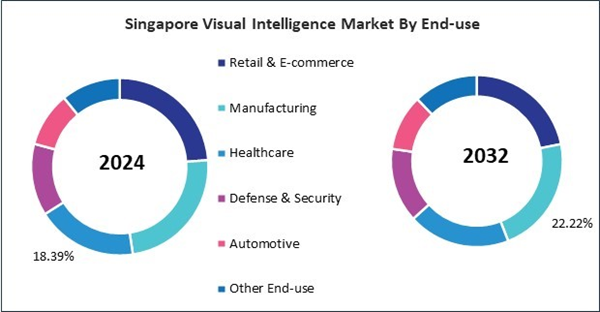The China market dominated the Asia Pacific Visual Intelligence Market by country in 2024, and is expected to continue to be a dominant market till 2032; thereby, achieving a market value of $4.00 billion by 2032. The Japan market is registering a CAGR of 18.8% during 2025-2032. Additionally, the India market is expected to showcase a CAGR of 20.3% during 2025-2032.
A dominant trend shaping the visual intelligence market is its integration with augmented reality (AR) and virtual reality (VR) platforms. As AR/VR hardware becomes more affordable and lightweight, industries like healthcare, retail, and education are leveraging visual intelligence to enhance immersive experiences. For example, in medical training, AI-powered vision systems interpret real-time hand gestures and tissue recognition to assist surgeons during procedures in simulated environments. Retailers use AR mirrors that rely on visual intelligence for virtual try-ons and personalized recommendations, improving customer engagement.
This convergence is not only enriching user interactivity but also unlocking new business models that rely on context-aware visualization. Another significant trend is the incorporation of visual intelligence in autonomous mobility systems. Self-driving vehicles heavily depend on AI vision technologies to interpret their surroundings, recognize road signs, detect obstacles, and make navigation decisions. Automotive OEMs and startups alike are developing multi-sensor fusion technologies that combine LIDAR, RADAR, and visual intelligence to ensure safer and more efficient autonomous driving.
The Asia Pacific Visual Intelligence Market has undergone significant transformation over the past decade, evolving from basic surveillance systems to sophisticated, AI-driven visual analytics platforms. This evolution is primarily attributed to rapid technological advancements, increased urbanization, and heightened security concerns across the region. In the early 2010s, countries like China, Japan, and South Korea began investing heavily in surveillance infrastructure to bolster public safety and urban management. China's "Made in China 2025" initiative, for instance, emphasized the development of advanced technologies, including visual intelligence, to modernize its manufacturing and surveillance capabilities.
Similarly, Japan's advancements in image sensor manufacturing have positioned it as a global leader in visual technology, impacting industries from consumer electronics to automotive safety systems. The integration of Artificial Intelligence (AI) and Machine Learning (ML) into visual systems marked a pivotal shift. These technologies enabled real-time data analysis, facial recognition, and predictive analytics, enhancing decision-making processes across various sectors. In India, the government's push for digital transformation led to the widespread adoption of AI-based visual intelligence in areas like traffic management and public safety.
China's visual intelligence market has experienced rapid growth, driven by substantial government investment and a robust tech ecosystem. The country's focus on AI and surveillance technologies has positioned it as a leader in visual intelligence applications. Initiatives like the "Made in China 2025" plan have prioritized the development of advanced technologies, including visual intelligence. The establishment of innovation hubs like the "China Vision Valley" in Hangzhou exemplifies the country's commitment to fostering a robust visual intelligence ecosystem. This hub aims to integrate digital security with visual intelligence, propelling the region towards becoming a leader in intelligent internet of things applications.
Japan's visual intelligence market is deeply rooted in its longstanding expertise in precision engineering and sensor technology. The nation has been at the forefront of developing high-performance image sensors, which serve as the backbone for various visual intelligence applications. Japanese manufacturers have pioneered advancements in image sensor technology, including backside illumination (BSI), global shutter mechanisms, and high dynamic range (HDR) capabilities. These innovations have significantly enhanced the performance, efficiency, and miniaturization of CMOS sensors, making them the preferred choice in modern electronics. The integration of artificial intelligence (AI) and machine learning (ML) into visual systems has further propelled Japan's position in the global market.
The nation has been at the forefront of developing high-performance image sensors, which serve as the backbone for various visual intelligence applications. Japanese manufacturers have pioneered advancements in image sensor technology, including backside illumination (BSI), global shutter mechanisms, and high dynamic range (HDR) capabilities. These innovations have significantly enhanced the performance, efficiency, and miniaturization of CMOS sensors, making them the preferred choice in modern electronics.
The integration of artificial intelligence (AI) and machine learning (ML) into visual systems has further propelled Japan's position in the global market. Japanese firms are leveraging these technologies to develop advanced visual inspection systems, which are increasingly being adopted in manufacturing processes to ensure quality control and operational efficiency. In conclusion, the visual intelligence market in the Rest of Asia Pacific region is experiencing robust growth, driven by urbanization, technological advancements, and the implementation of smart city initiatives.
List of Key Companies Profiled
- NVIDIA Corporation
- IBM Corporation
- Microsoft Corporation
- Amazon Web Services, Inc. (Amazon.com, Inc.)
- Google LLC (Alphabet Inc.)
- Omron Corporation
- Cognex Corporation
- Meta Platforms, Inc.
- Qualcomm Incorporated (Qualcomm Technologies, Inc.)
- Intel Corporation
Market Report Segmentation
By Technology
- Computer Vision
- Deep Learning
- Machine Learning
- Image Processing
By End-use
- Retail & E-commerce
- Manufacturing
- Healthcare
- Defense & Security
- Automotive
- Other End-use
By Application
- Surveillance & Security
- Quality Inspection & Automation
- Facial Recognition
- Image & Video Analytics
- Predictive Maintenance
- Traffic Monitoring
- Retail Analytics
By Country
- China
- Japan
- India
- South Korea
- Singapore
- Malaysia
- Rest of Asia Pacific
Table of Contents
Companies Mentioned
- NVIDIA Corporation
- IBM Corporation
- Microsoft Corporation
- Amazon Web Services, Inc. (Amazon.com, Inc.)
- Google LLC (Alphabet Inc.)
- Omron Corporation
- Cognex Corporation
- Meta Platforms, Inc.
- Qualcomm Incorporated (Qualcomm Technologies, Inc.)
- Intel Corporation









